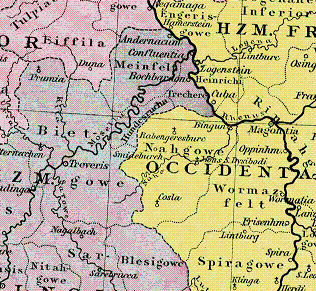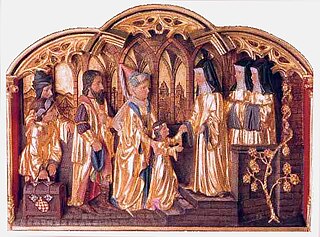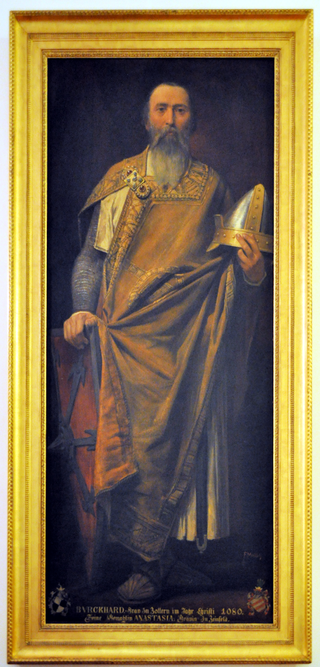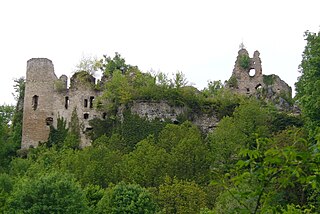Related Research Articles

Hildegard of Bingen, also known as Saint Hildegard and the Sibyl of the Rhine, was a German Benedictine abbess and polymath active as a writer, composer, philosopher, mystic, visionary, and as a medical writer and practitioner during the High Middle Ages. She is one of the best-known composers of sacred monophony, as well as the most recorded in modern history. She has been considered by scholars to be the founder of scientific natural history in Germany.
Benjamin Bagby is an American singer, composer, harpist, and performer of medieval music.

Count Adolf VI of Berg ruled the County of Berg from 1197 until 1218.
Erenfried II was a Lotharingian nobleman, from the area of Bonn in what is now Germany. According to one proposal, he was a son of Eberhard I, Count of Bonngau and Zülpichgau. He could otherwise be the same as Ehrenfrid, son of Ricfrid.

Saint Bertha of Bingen was the mother of Rupert of Bingen. Her biography was written, and subsequently her cult popularized, by Hildegard of Bingen, who lived in the same region, about four hundred years later. Bertha and Rupert share a feast day on 15 May.

The Counts of Ortenburg were a comital family in the mediaeval Duchy of Carinthia. Though they had roots in Bavarian nobility, an affiliation with the Imperial Counts of Ortenburg, a branch line of the Rhenish Franconian House of Sponheim, is not established.

The County of Sponheim was an independent territory in the Holy Roman Empire that lasted from the 11th century until the early 19th century. The name comes from the municipality of Sponheim, where the counts had their original residence.

The Trechirgau was a mediaeval administrative district, a gau. It belonged to the Duchy of Lorraine. Its exact extent is only roughly known and it lay in the triangle formed by Enkirch, Koblenz and Oberwesel.

Countess Jutta von Sponheim was the youngest of four noblewomen who were born into affluent surroundings in what is currently the Rhineland-Palatinate. She was the daughter of Count Stephen of Spanheim.

Vision is a 2009 German film directed by Margarethe von Trotta.
Donald Charles Jackman is an American medievalist and linguist of Australian background.
The Emichones were an early medieval family in the southwestern German region. Its members were counts (Gaugrafen) in the Nahegau, perhaps as undercounts of the Salian dynasty. The conventional name Emichones is due to the prevailing first name "Emich". Several later families may trace their origins to the Emichones.
The Berthold-Bezelins were a German noble family from the 10th century, whose sphere of influence and property laid about the Trechirgau and Maifeldgau. They were the Counts of Stromberg before that county became a part of the Electorate of the Palatinate. The family is named after the prevailing first name Berthold, and its variation Bezelin. The Berthold-Bezelins supposedly descended from the Ernestiner and through them from the Luitpoldinger Dukes of Bavaria as a junior lineage.

Burkhard I, Lord of the House of Hohenzollern is considered the first well-documented ancestor of the Hohenzollern dynasty. Because of his name, it has been attempted to link the Hohenzollern family's descent to the medieval Burchardings family, but without success. His father may have been Friedrich, a count in the Sülichgau area. His mother may have been Irmentrud, the daughter of Count Burkhard of Nellenburg.
The Ensemble für frühe Musik Augsburg is a German early music ensemble founded in 1977 and specializing in medieval music. The ensemble is regarded as "renowned" in Germany.

AdalbertIICount of Mörsberg was Vogt of the monasteries Allerheiligen in Schaffhausen, Switzerland, and Pfaffen-Schwabenheim near Bad Kreuznach, Germany, Count of Dill, Germany, and Mörsberg, as well as owner of the Mörsburg castle near Winterthur.
Rudolf I, Margrave of the Nordmark and Count of Stade, son of Lothair Udo II, Margrave of the Nordmark, and Oda of Werl, daughter of Herman III, Count of Werl, and Richenza of Swabia. Rudolf was the brother of his predecessors Henry I the Long and Lothair Udo III.
Stephen II was a German nobleman and an early member of the House of Sponheim. He succeeded his father, Stephen I, as count of Sponheim around 1080. Around 1092 Stephen married Sophia of Formbach. Stephen had several children with Sophia, including Meginard I, who succeeded him as count of Sponheim and Jutta, abbess of the Benedictine monastery on Disibodenberg and teacher of Hildegard of Bingen.
Adelaide of Weimar-Orlamünde was the daughter of Otto I of Meissen and a member of the family of the counts of Weimar and Orlamünde. She married successively, Adalbert II of Ballenstedt, count palatine Herman II, and Henry of Laach.
Sophia of Formbach, was the daughter of Meginhard V of Formbach. She was countess of Salm through her marriage to Hermann of Salm, who was also elected German anti-king from 1081 to 1088.
References
- ↑ (in German) Mitteilungen der Residenzen-Kommission der Akademie der Wissenschaften zu Göttingen, Heft 16/1, 2006. http://resikom.adw-goettingen.gwdg.de/MRK/MRK16-1.htm
- ↑ (in German) Heinzelmann, Josef. Spanheimer-Späne -- Schachwappen und Konradinererbe. http://www.genealogie-mittelalter.de/heinzelmann_josef/spanheimer_spaene.html
- ↑ (in German) Heinzelmann, Josef. Hildegard von Bingen und ihre Verwandten -- Genealogische Anmerkungen. http://www.genealogie-mittelalter.de/heinzelmann_josef/hildegard_von_bingen.html
- ↑ Jackman, Donald C.. Stromburg. Medieval German Counties. Medieval Prosopography. http://www.enlaplage.com/prosop/counts/countyA/county85.htm
- ↑ (in German) Heinzelmann, Josef. Ludwig von Arnstein und seine Verwandtschaft -- Zur mitteleuropäischen Adelsgeschichte um 1100. http://www.genealogie-mittelalter.de/heinzelmann_josef/ludwig_von_arnstein.html